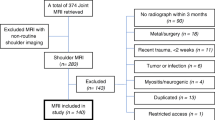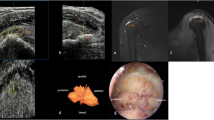Abstract
Introduction
The aim of this study was to evaluate the difference in the acromiohumeral distance (AHD) between the shoulders with full-thickness rotator cuff tear and contralateral healthy shoulders of the same patients on magnetic resonance imaging (MRI) and radiograph.
Materials and methods
We included 49 patients with unilateral full-thickness rotator cuff tears. The mean age of the patients (29 women and 20 men) was 54.57 ± 7.10 years. The shoulders were divided into those with a full-thickness rotator cuff tear and healthy shoulders. The mean AHDs on radiograph and MRI were calculated by two radiologists experienced in the musculoskeletal system. Shoulders with rotator cuff tears on coronal plane and sagittal MRI were divided into 3 (Patte I, II, III) and 4 subgroups (S: superior, AS: anterosuperior, PS: posterosuperior, APS: anteroposterosuperior), respectively. The relationship between the groups and the subgroups was statistically investigated.
Results
The mean AHDs on radiograph were 6.93 and 9.11 mm and on MRI were 5.94 and 7.46 mm in the patient and control groups, respectively. The mean AHDs were 6.47, 6.03, and 4.95 mm in Patte I, II, and III, respectively. The difference between the subgroups was statistically significant. According to the sagittal plane topography, the mean AHDs (mm) were 6.39, 6.44, 5.8, and 4.6 mm in the superiorly, anterosuperiorly, posterosuperiorly, and anteroposterosuperiorly localized lesions, respectively. The relationship between S and AS was not statistically significant, and those between S and PS, AS and PS, S and APS, and PS and APS were significant.
Conclusions
In patients with unilateral full-thickness rotator cuff tear, AHD narrowing was observed on the törnekler side after evaluating the bilateral acromiohumeral distance on MRI and radiograph. AHD was significantly reduced by increasing the degree of supraspinatus tendon retraction in the coronal plane MRI and by the posterosuperior and anteroposterosuperior location of the rotator cuff tear in the sagittal plane MRI.

Similar content being viewed by others
Change history
09 February 2022
A Correction to this paper has been published: https://doi.org/10.1007/s00402-022-04377-6
References
Pandey V, Willems WJ (2015) Rotator cuff tear: a detailed update. Asia Pac J Sports Med Arthrosc Rehabil Technol 2:1–14
Cetinkaya M, Ataoglu MB, Ozer M, Ayanoglu T, Oner AY, Kanatli U (2018) Do subscapularis tears really result in superior humeral migration? Acta Orthop Traumatol Turc 52:109–114
Weiner DS, Macnab I (1970) Superior migration of the humeral head. A radiological aid in the diagnosis of tears of the rotator cuff. J Bone Joint Surg Br 52:524–527
Inman VT, Saunders JB, Abbott LC (1996) Observations of the function of the shoulder joint. Clin Orthop Relat Res. 330:3–12
Burkhart SS (1997) Partial repair of massive rotator cuff tears: the evolution of a concept. Orthop Clin North Am 28:125–132
Burkhart SS (2000) A stepwise approach to arthroscopic rotator cuff repair based on biomechanical principles. Arthroscopy 16:82–90
Hansen ML, Otis JC, Johnson JS, Cordasco FA, Craig EV, Warren RF (2008) Biomechanics of massive rotator cuff tears: implications for treatment. J Bone Joint Surg Am 90:316–325
Mirzayan R, Donohoe S, Batech M, Suh BD, Acevedo DC, Singh A (2020) Is there a difference in the acromiohumeral distances measured on radiographic and magnetic resonance images of the same shoulder with a massive rotator cuff tear? J Shoulder Elbow Surg 29:1145–1151
Kim SJ, Park JS, Lee KH, Lee BG (2016) The development of a quantitative scoring system to predict whether a large-to-massive rotator cuff tear can be arthroscopically repaired. Bone Joint J 98-B:1656–1661
Kelly BT, Williams RJ, Cordasco FA, Backus SI, Otis JC, Weiland DE et al (2005) Differential patterns of muscle activation in patients with symptomatic and asymptomatic rotator cuff tears. J Shoulder Elbow Surg 14:165–171
Razmjou H, Palinkas V, Christakis M, Robarts S, Kennedy D (2020) Reduced acromiohumeral distance and increased critical shoulder angle: implications for primary care clinicians. Phys Sportsmed 48:312–319
Werner CM, Conrad SJ, Meyer DC, Keller A, Hodler J, Gerber C (2008) Intermethod agreement and interobserver correlation of radiologic acromiohumeral distance measurements. J Shoulder Elbow Surg 17:237–240
Mantell MT, Nelson R, Lowe JT, Endrizzi DP, Jawa A (2017) Critical shoulder angle is associated with full-thickness rotator cuff tears in patients with glenohumeral osteoarthritis. J Shoulder Elbow Surg 26:e376–e381
Moor BK, Bouaicha S, Rothenfluh DA, Sukthankar A, Gerber C (2013) Is there an association between the individual anatomy of the scapula and the development of rotator cuff tears or osteoarthritis of the glenohumeral joint?: A radiological study of the critical shoulder angle. Bone Joint J. 95-b:935–41.
Keener JD, Wei AS, Kim HM, Steger-May K, Yamaguchi K (2009) Proximal humeral migration in shoulders with symptomatic and asymptomatic rotator cuff tears. J Bone Joint Surg Am 91:1405–1413
Nové-Josserand L, Boulahia A, Levigne C, Noel E, Walch G (1999) Coraco-humeral space and rotator cuff tears. Rev Chir Orthop Reparatrice Appar Mot 85:677–683
Nové-Josserand L, Lévigne C, Noël E, Walch G (1996) The acromio-humeral interval. A study of the factors influencing its height. Rev Chir Orthop Reparatrice Appar Mot 82:379–385
Gumina S, Arceri V, Fagnani C, Venditto T, Catalano C, Candela V et al (2015) Subacromial space width: Does overuse or genetics play a greater role in determining it? an MRI study on elderly twins. J Bone Joint Surg Am 97:1647–1652
Patte D (1990) Classification of rotator cuff lesions. Clin Orthop Relat Res. 81–6.
Golding FC (1962) The shoulder–the forgotten joint. Br J Radiol 35:149–158
Cotton RE, Rideout DF (1964) Tears of the humeral rotator cuff; A radiological and pathological necropsy survey. J Bone Joint Surg Br 46:314–328
Goupille P, Anger C, Cotty P, Fouquet B, Soutif D, Valat JP (1993) Value of standard radiographies in the diagnosis of rotator cuff rupture. Rev Rhum Ed Fr 60:440–444
Nové-Josserand L, Edwards TB, O’Connor DP, Walch G (2005) The acromiohumeral and coracohumeral intervals are abnormal in rotator cuff tears with muscular fatty degeneration. Clin Orthop Relat Res 433:90–96
Lee KW, Lee SH, Jung SH, Kim HY, Ahn JH, Kim KJ, Choy WS (2008) The effect of the acromion shape on rotator cuff tears. J Korean Orthop Assoc 43:181–186
De Oliveira FF, Godinho AC, Ribeiro EJ, Falster L, Búrigo LE, Nunes RB (2016) Evaluation of the acromiohumeral distance by means of magnetic resonance imaging umerus. Rev Bras Ortop 51:169–174
Saupe N, Pfirrmann CW, Schmid MR, Jost B, Werner CM, Zanetti M (2006) Association between rotator cuff abnormalities and reduced acromiohumeral distance. AJR Am J Roentgenol 187:376–382
Vanderstukken F, Maenhout A, Spanhove V, Jansen N, Mertens T, Cools AM (2020) Quantifying acromiohumeral distance in elite male field hockey players compared to a non-athletic population. Braz J Phys Ther 24:273–279
Author information
Authors and Affiliations
Corresponding author
Additional information
Publisher's Note
Springer Nature remains neutral with regard to jurisdictional claims in published maps and institutional affiliations.
Rights and permissions
About this article
Cite this article
Sürücü, S., Aydın, M., Çapkın, S. et al. Evaluation of bilateral acromiohumeral distance on magnetic resonance imaging and radiography in patients with unilateral rotator cuff tears. Arch Orthop Trauma Surg 142, 175–180 (2022). https://doi.org/10.1007/s00402-021-04026-4
Received:
Accepted:
Published:
Issue Date:
DOI: https://doi.org/10.1007/s00402-021-04026-4




